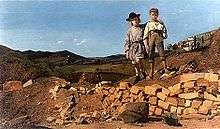Jane Benham Hay


Jane Benham (born 1829) (also Jane Benham Hay and Jaine Benham Hay) was a prominent female painter and illustrator of the Victorian period. She was associated with two important artistic movements of the mid-nineteenth century: the Pre-Raphaelite painters of Britain, and the Macchiaioli of Italy.
Biography
Jane Benham was born in London in 1829 to a family of iron and metal workers. She traveled to Munich in 1850 with her friend Anna Mary Howitt (1824–1884).[1] Together, they hoped to engage in serious study of drawing and painting. After their arrival in Munich, it became clear to them that women would not be permitted to study at the Academy in Düsseldorf. Undeterred, they approached Wilhelm von Kaulbach, then the director of the Academy, and requested the privilege of private study in his studio. He agreed, and permitted them to work in his studio at liberty, although it is not clear how much formal instruction he gave them. Jane stayed in Munich until December 1850, when she was compelled to return to London. Anna Mary remained in Munich for two full years, returning to London in 1852. Upon her return, she compiled her diary and personal letters into a text, An Art Student in Munich, which was published in 1853 and reissued in 1880. In this text, Anna Mary uses the pseudonym Clare to refer to Jane Benham.[2]
Jane married artist William Hay in 1851 and they had a son the following year. However, their marriage did not last long and Jane left London to move to Florence in the mid-1850s. Around the same time, she met Francesco Saverio Altamura (b. 1822 or 1826- d. 1897), a painter who had associated with Macchiaioli painters of Tuscany, who are considered the Italian precursors to the Impressionists. Altamura had had a colorful life, and had a predilection for historical and religious paintings. They married and had one son together, Bernardo Hay (1864-1934).
Jane Benham Hay exhibited at the Royal Academy in 1848, 1849, 1859, 1861, and 1862.[3] Her two entries of 1859, England and Italy and Portrait of a Boy in Florentine Costume, established her reputation. Painted just prior to the unification of Italy, England and Italy was a powerful statement in favor of democratic unification, as well as a compelling work of art. John Ruskin noted that both works were "masterly complete in effect,".[4] although he did not care for the political overtones. England and Italy went missing some time after 1859, and was not rediscovered until the late 1990s.
In 1867 Jane Hay achieved her greatest professional success with The Florentine Procession, also known as The Burning of the Vanities, which was exhibited by Henry Wallis at the French Gallery in London. This painting is now in the collection of Homerton College, Cambridge.
Her later life is not well documented, and her date of death is not known.
See also
- English women painters from the early 19th century who exhibited at the Royal Academy of Art
- Sophie Gengembre Anderson
- Mary Baker
- Ann Charlotte Bartholomew
- Maria Bell
- Barbara Bodichon
- Joanna Mary Boyce
- Margaret Sarah Carpenter
- Fanny Corbaux
- Rosa Corder
- Mary Ellen Edwards
- Harriet Gouldsmith
- Mary Harrison (artist)
- Anna Mary Howitt
- Mary Moser
- Martha Darley Mutrie
- Ann Mary Newton
- Emily Mary Osborn
- Kate Perugini
- Louise Rayner
- Ellen Sharples
- Rolinda Sharples
- Rebecca Solomon
- Elizabeth Emma Soyer
- Isabelle de Steiger
- Henrietta Ward
Notes
- ↑ Marsh and Nunn, Pre-Raphaelite Women Artists, Manchester City Art Galleries, 1997, p. 109
- ↑ Nunn, ed. Canvassing, 1986, p. 24
- ↑ Orr, Women in the Victorian Art World, 1995, p. 120.
- ↑ Ruskin, Academy Notes, Cook and Wedderburn, editors, Library Edition of the Collected Works of John Ruskin, London, 1903-1912, vol. 14, pp. 211-212.
References
- Howitt, Anna Mary. An Art Student in Munich, Boston: Ticknor, Reed, and Fields, 1854
- Jan Marsh and Pamela Gerrish Nunn, editors. Pre-Raphaelite Women Artists, Manchester City Art Galleries, 1997. ISBN 0-901673-55-2
- Nunn, Pamela Gerrish (Ed.) Canvassing: Recollections by six Victorian Women Artists London: Camden Press Ltd., 1986 ISBN 0-948491-01-9
- A. Chapman and J. Stabler, editors. Unfolding the South: Nineteenth-century British women writers and artists in Italy, Manchester University Press, 2003. ISBN 0-7190-6130-X
- Orr, Clarissa. Women in the Victorian Art World, Manchester University Press, 1995. ISBN 0-7190-4123-6